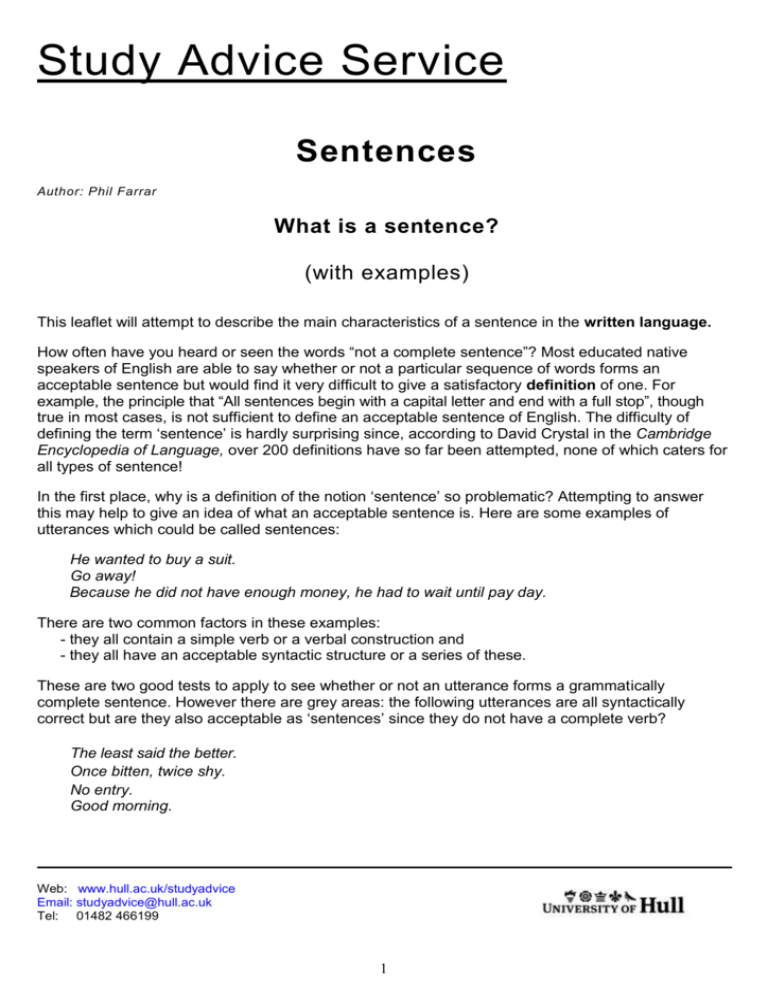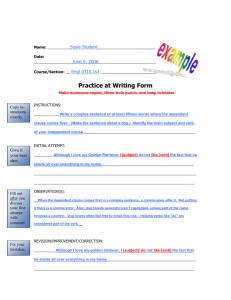Study Advice Service Sentences Author: Phil Farrar What is a
advertisement

Study Advice Service Sentences Author: Phil Farrar What is a sentence? (with examples) This leaflet will attempt to describe the main characteristics of a sentence in the written language. How often have you heard or seen the words “not a complete sentence”? Most educated native speakers of English are able to say whether or not a particular sequence of words forms an acceptable sentence but would find it very difficult to give a satisfactory definition of one. For example, the principle that “All sentences begin with a capital letter and end with a full stop”, though true in most cases, is not sufficient to define an acceptable sentence of English. The difficulty of defining the term ‘sentence’ is hardly surprising since, according to David Crystal in the Cambridge Encyclopedia of Language, over 200 definitions have so far been attempted, none of which caters for all types of sentence! In the first place, why is a definition of the notion ‘sentence’ so problematic? Attempting to answer this may help to give an idea of what an acceptable sentence is. Here are some examples of utterances which could be called sentences: He wanted to buy a suit. Go away! Because he did not have enough money, he had to wait until pay day. There are two common factors in these examples: - they all contain a simple verb or a verbal construction and - they all have an acceptable syntactic structure or a series of these. These are two good tests to apply to see whether or not an utterance forms a grammatically complete sentence. However there are grey areas: the following utterances are all syntactically correct but are they also acceptable as ‘sentences’ since they do not have a complete verb? The least said the better. Once bitten, twice shy. No entry. Good morning. Web: www.hull.ac.uk/studyadvice Email: studyadvice@hull.ac.uk Tel: 01482 466199 1 Some linguists suggest an answer to this question by saying that “All native speakers can recognise a well-formed utterance.” but whether or not it can be classified as a sentence begs the question for theorists. So, we could say that He will arrive later this afternoon. or Later this afternoon, he will arrive. are acceptable sentences but that the following are not, since the order in which the units combine does not follow an acceptable syntactic pattern or because the utterance is semantically incomplete (i.e. it does not convey a complete meaning or idea): He will later this afternoon arrive. Arrive later this afternoon he will. He later this afternoon. Since English has long ago dispensed with concordance and inflexions at the end of words to show the grammatical relationship between them, word order is often crucial to the meaning of an utterance. The sentences and He knows the result He will ring with all the details are each correct and complete but simply joining the two together will not make an acceptable sentence. To achieve this, one He will need to be deleted to avoid repetition and the addition of the word when or but is required to produce: or or When he knows the result, he will ring with all the details. He will ring with all the details when he knows the result. He will ring with all the details, but he knows the result. (The last two examples have slightly different meanings since the logical connection between the two halves of the sentence - when/but - is not the same. It is interesting to note here that, in formal written English, it is advisable not to start sentences with but and that the Present Tense is used to convey a future meaning, illustrating the fact that human language is not an exact science and not always logical - thank goodness!) So, a sentence could be defined as ‘the largest unit [of language] to which syntactic rules apply’ 1. It is a good idea, especially for non-native speakers of English, not to construct sentences which are too long in order to avoid problems with syntax. Often, one becomes so engrossed in communicating the meaning or series of ideas that the sentence is syntactically jumbled or incomplete, but it may be the confusion of subject and verb, or a lack of one of these, which causes the problem. Some examples showing constructional and other errors may serve to illustrate the point: 1. Crystal D. (1997) “The Cambridge Encyclopedia of Language” C.U.P. p. 94 2 Non -s e nte nc e Corre c te d ex a mple “Although the XXXX Act 1991 came into force, which play a key role in the draft, but to what extent the YYY will improve the situation for consumers.” The XXXX Act came into force in 1991 and it plays a key role in the draft, but to what extent will the YYY improve the situation for consumers? Remarks: - which is too far from the noun phrase to which it refers (the XXXX Act). Structure: [Main clause] + and + [main clause] + but + [main clause] - there is no main clause for the subordinate clause beginning “Although …” Note that each main clause has its own complete verbal form, came into force, plays, will …improve. - the modal (auxiliary) verb will should precede the subject of the main verb improve, thus changing the statement into a question - the direct question (to what extent…) has no question mark or: Although the XXXX Act came into force in 1991 and plays a key role in the draft, to what extent will the YYY improve the situation for consumers? Structure: [Subordinate clause] + and + [subordinate clause] + [main clause] Here too, each clause has a complete verbal form (see above) With the development of economies, companies need to meet higher standards. Structure: [noun phrase] + [main clause] or: “With the development of the economies, higher The development of economies requires standards require for companies to meet.” companies to meet higher standards. Remarks: - the second the is not needed. [main clause] - require is a transitive verb and has a direct object, so there is no for. - here, the verb meet would mean that the companies would need to meet each other. Meet can also be transitive, in which case the sentence is incomplete and would require an object e.g. “ … to meet certain criteria.” 3 “This theory closely linked with the stakeholders, This theory is closely linked with the stakeholders (who are) the underlying elements the underlying elements of corporate of corporate governance. governance.” Remarks: - there is no finite or tensed verb, so there is not a complete sentence. Structure: [main clause] + [relative clause] “Focuses on the company, its survival closely associated with some other social parts in broader social system.” [This essay] focuses on the company. Its survival is closely associated with some other aspects of the broader social system. Remarks: - the verb focuses has no subject and associated with is not a complete construction: there is no auxiliary verb. - the meaning of social parts is unclear. - there is repetition of the word social. Structure: [main clause] + [main clause] or: [This essay] focuses on the company, whose survival is closely associated with the broader social system. Structure: [main clause] + [relative clause] “Ethical stakeholders, that is, regardless of whether there is an improvement of financial performance, management should take account into all stakeholders’ benefits, such as human rights, public relations and environmental performance.” Regardless of whether or not there is an improvement of financial performance, management should take account of all stakeholders’ benefits … Structure: [subordinate clause] + [main clause] Remarks: Note that this sentence is simpler and avoids - that is is not needed. - whether should be followed by or not since repetition of the word performance. there is an implied comparison or alternative - the phrasal verb is to take account of, not into, something (but we do say to take something into account). - take account has two different subjects. Who is taking account of what? If it is the management which is taking shareholders into account, then the first two words of the ‘sentence’ are not needed either. All web addresses in this leaflet were correct at the time of publication. The information in this leaflet can be made available in an alternative format on request. Telephone 01482 466199. © 10/2007 4







